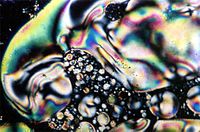
Photo from wikipedia
Multidimensional solid-state NMR spectra of oriented membrane proteins can be used to infer the backbone torsion angles and hence the overall protein fold by measuring dipolar couplings and chemical shift… Click to show full abstract
Multidimensional solid-state NMR spectra of oriented membrane proteins can be used to infer the backbone torsion angles and hence the overall protein fold by measuring dipolar couplings and chemical shift anisotropies, which depend on the orientation of each peptide plane with respect to the external magnetic field. However, multiple peptide plane orientations can be consistent with a given set of angular restraints. This ambiguity is further exacerbated by experimental uncertainty in obtaining and interpreting such restraints. The previously developed algorithms for structure calculations using angular restraints typically involve a sequential walkthrough along the backbone to find the torsion angles between the consecutive peptide plane orientations that are consistent with the experimental data. This method is sensitive to experimental uncertainty in interpreting the peak positions of as low as ± 10 Hz, often yielding high structural RMSDs for the calculated structures. Here we present a significantly improved version of the algorithm which includes the fitting of several peptide planes at once in order to prevent propagation of error along the backbone. In addition, a protocol has been devised for filtering the structural solutions using Rosetta scoring functions in order to find the structures that both fit the spectrum and satisfy bioinformatics restraints. The robustness of the new algorithm has been tested using synthetic angular restraints generated from the known structures for two proteins: a soluble protein 2gb1 (56 residues), chosen for its diverse secondary structure elements, i.e. an alpha-helix and two beta-sheets, and a membrane protein 4a2n, from which the first two transmembrane helices (having a total of 64 residues) have been used. Extensive simulations have been performed by varying the number of fitted planes, experimental error, and the number of NMR dimensions. It has been found that simultaneously fitting two peptide planes always shifted the distribution of the calculated structures toward lower structural RMSD values as compared to fitting a single torsion-angle pair. For each protein, irrespective of the simulation parameters, Rosetta was able to distinguish the most plausible structures, often having structural RMSDs lower than 2 Å with respect to the original structure. This study establishes a framework for de-novo protein structure prediction using a combination of solid-state NMR angular restraints and bioinformatics.
Journal Title: Journal of Biomolecular NMR
Year Published: 2019
Link to full text (if available)
Share on Social Media: Sign Up to like & get
recommendations!